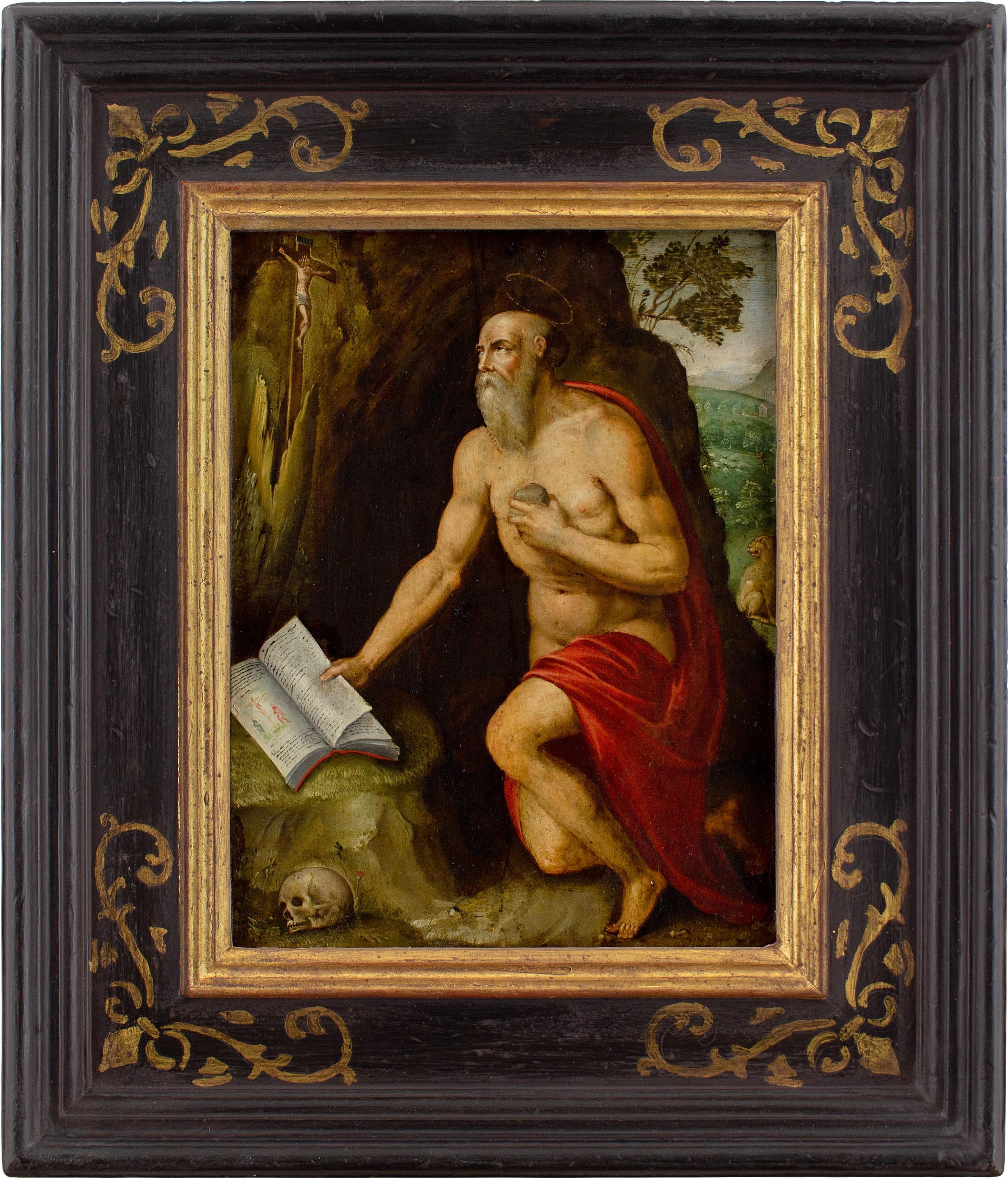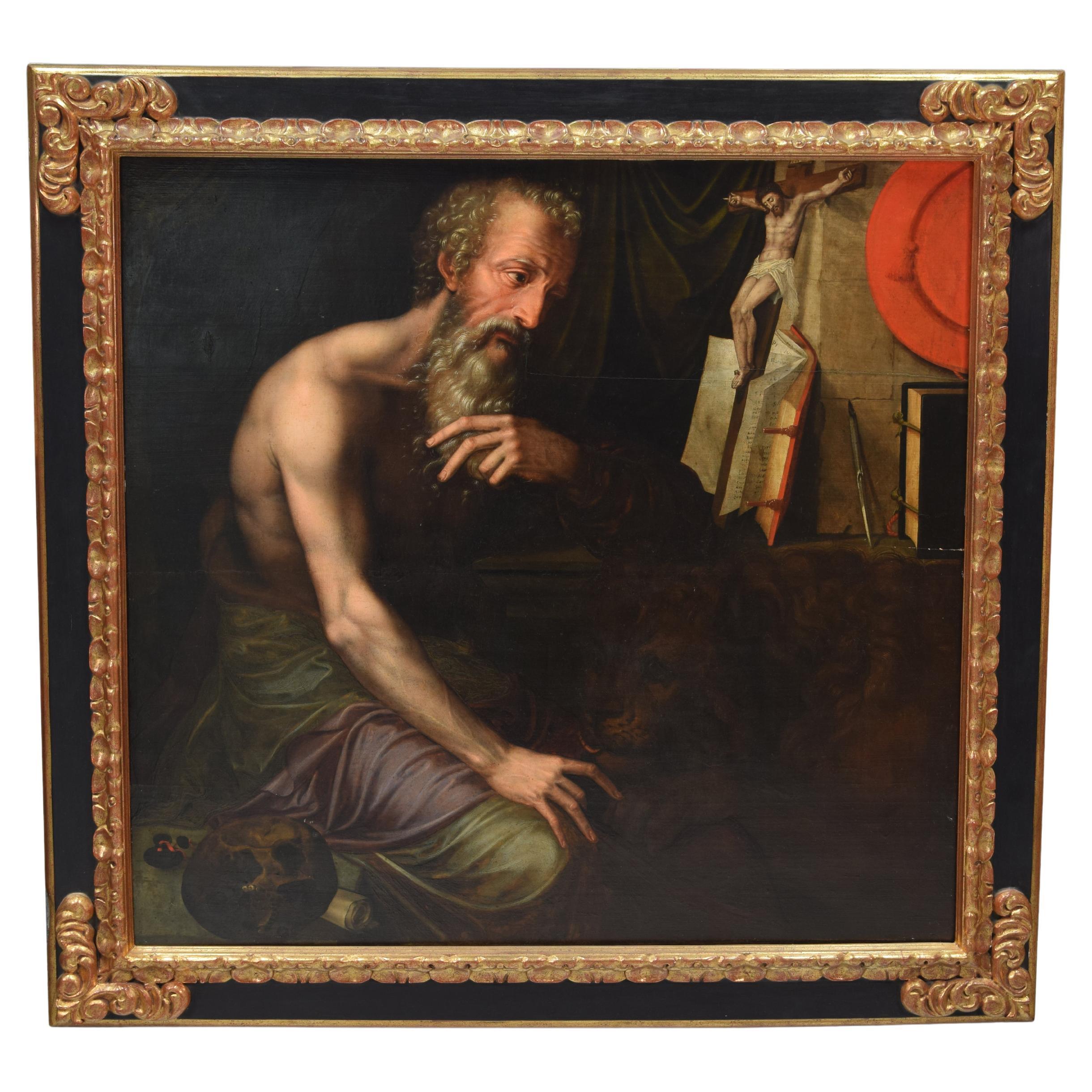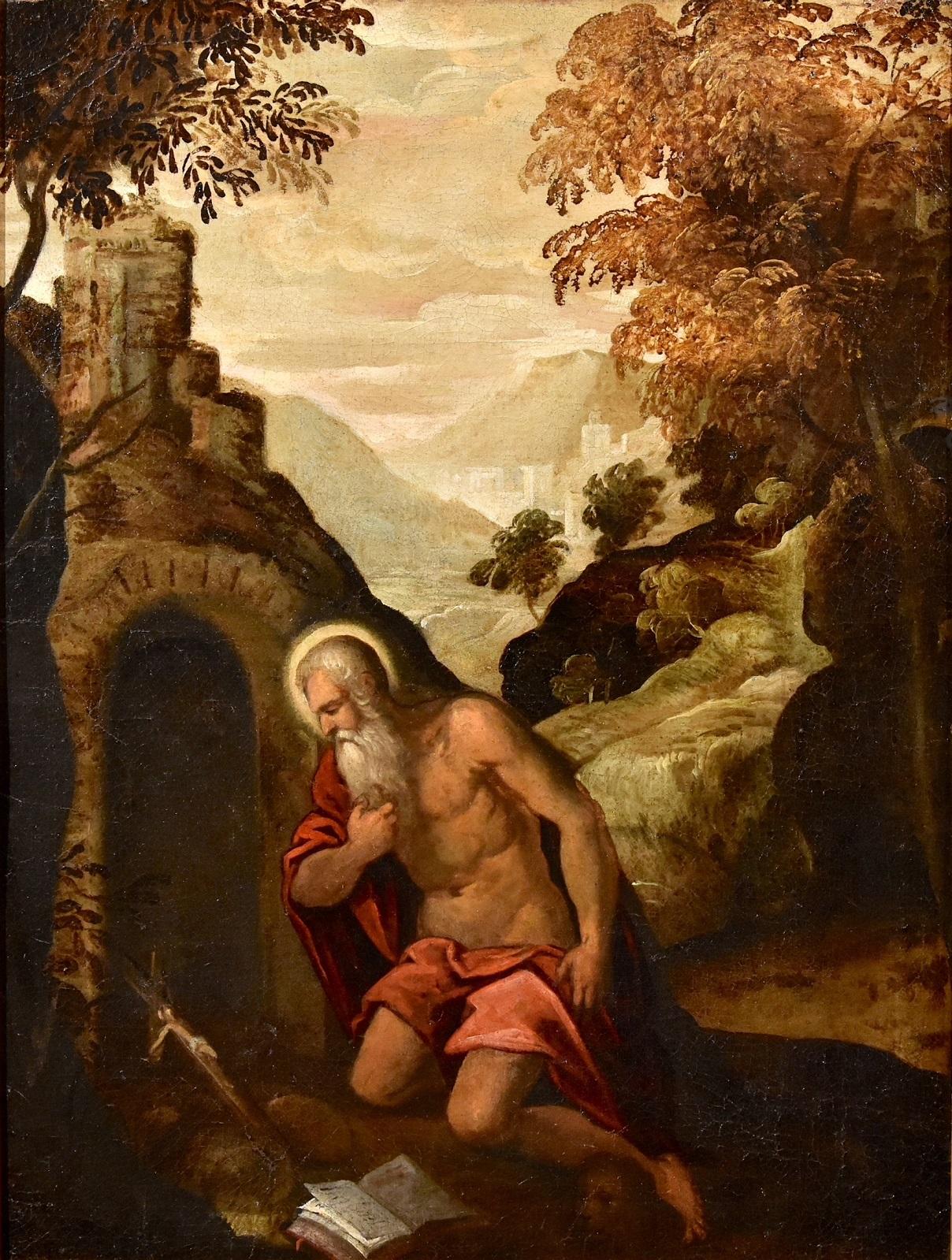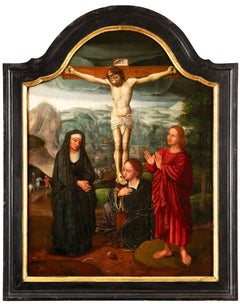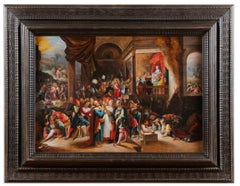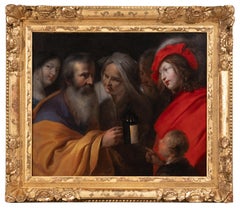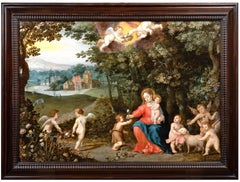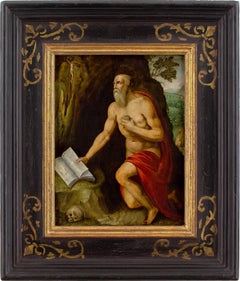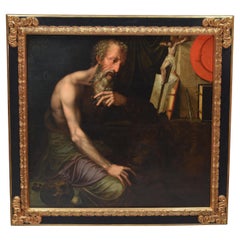Items Similar to Saint Jerome, Antwerp, 16th century, circa 1550, cercle of Lambert Van Noort
Want more images or videos?
Request additional images or videos from the seller
1 of 15
Saint Jerome, Antwerp, 16th century, circa 1550, cercle of Lambert Van Noortcirca 1550
circa 1550
$33,301.04
£24,933.52
€28,000
CA$46,574.46
A$50,762
CHF 26,434.56
MX$612,481
NOK 332,293.08
SEK 311,945.91
DKK 213,306.95
About the Item
Saint Jerome in the desert
Cercle of Lambert Van Noort (1520-1571, Antwerp)
Antwerp School, mid-16th century
Oil on oak panel.
Dimensions: panel h. 69 cm (27.16 in), l. 52.5 cm (20.67 in)
With frame: h. 113 cm, l. 98 cm (44.49x38.58 in)
Very important giltwood tabernacle frame, Italy, 16th century
The life and writings of Saint Jerome were an inexhaustible source of inspiration for artists of the late Middle Ages and the Renaissance.
In Italy and in Nothern Europe, two parallel iconographies are formed, depicting an aged and bearded Saint Jerome. The first showed him near his cave, kneeling before the crucifix, the clothes thrown to the ground. The second represented him in his study, dressed in a red coat in the middle of books and writings.
Our work, dating from the mid-16th century is distinguished by a humanist representation of the saint, the sacred figure is replaced by a simple human being with realistic features. The balding and skeletal old man usually illustrated is replaced here by a younger, muscular man with beautiful hair and beard. This iconographic break will continue throughout 16th century influenced by the humanist movement which developed at that time. During the Renaissance, Saint Jerome became the symbol of the union of Christian faith with the philosophy of Greco-Roman antiquity.
Our artist depicts Saint Jerome sheltered in a cave during his retirement in the desert. In the act of worship and penance, kneeling before the crucifix, he is about to hit himself with a stone, while looking at the sky.
He is dressed in a white blouse (symbol of purity) and wrapped in a large pink cardinal's mantle. His clothes reveal his chest, left arm and knee.
The lion, the saint's companion is lying close to him, he looks at the spectator with his large hazel eyes and surprises by his face with human features.
The crucifix is placed behind a stone slab or an inscription in Gothic letters confirms the identity of the saint. The cardinal's hat is thrown to the ground. A gospel with red cover is placed on the stone.
The saint's face shows fine and regular features, the white hair brushed back revealing the forehead, his mustache and his long beard. His meditative and serene look from his eyes raised to the sky contrasts with the tension of his body, his half-open frozen mouth, his hand tightly squeezing the stone, the swollen muscles, tendons and veins reflecting the bodily resistance of the saint in his act of flogging. An approach illustrating that behind a Saint hides an ordinary man.
This body of a mature man, with protruding muscles surprises by the aristocratic whiteness and the transparency of his skin revealing the bluish veins.
The drapery work is particularly successful, influenced by a strong Gothic influence with broken and angular folds. Strong lighting displays the transitions between light and shade. Gradient colors ranging from purple to white, including all shades of pink distinguish the hollows and ridges. The edges of his tunic are decorated with a pattern made of sgrafitto.
The cave opens onto the landscapes on each side, they are deliberately reproduced at different heights, on the left a hilly landscape with two castles and a hermit chapel at the foot of a mountain, with a winding path in front. On the right, however, a lower area with a fenced building. These landscapes of the Flemish countryside make it possible to position the saint in contemporary space-time for the execution of the work.
Even if the landscape is not the main subject of our painting, it surprises by its precision and realism and takes a certain autonomy in the composition thanks to the process of veduta, opening on the outside environment.
The figure of the saint stands out against the brown background of the cave, the arid land is dotted with small groups of very finely painted vegetation, with carefully drawn leaves and flowers. These vegetal strands are reminiscent of the margins of sheets of Books of hours. An aspect undeniably testifying to the Gothic influence.
The cold palette is dominated by the blue-green shades of the landscape with the icy pink of the tunic. The alternation of color grounds contributes to building the depth: brown for the foreground, green for the second plan, blue for the horizon.
The attention to detail, the modeling of the figure as well as the large sculptural drapes create a work of great sensitivity and great aesthetic quality.
As with many works realized during this era, the identity of our artist remains unknown. However, it is obvious that his source of inspiration lies in the works and several painters from his artistic circle.
The treatment of drapery is very close to the works of Bernard van Orley as well as the crucifix which is identical to that of St Jerome at the museum of Cadiz (Spain), however Van Orley continues to follow the archaic model of an emaciated old man.
Finally the closest work as much by its central figure and its composition with opening onto two landscapes as by its cold palette is a painting resulting from a collaboration between Lambert Van Noort and Henri de Bles (for landscape), St Jerome penitent exposed at the museum of Namur, Belgium. This Saint Jerome displays like that of our painting a healthy, harmonious and muscular body.
It becomes obvious that our work combining two influences and styles marks a new stage in Antwerp painting, a progressive abandonment of the precepts of Gothic art and the archetypes of religious art in favor of Renaissance art guided by the humanist vision and the central place reserved for man.
Very important giltwood tabernacle frame, Italy, 16th century
In richly carved giltwood, shaped in the form of a portico of an ancient temple with fluted pilasters with Ionic capitals belonging to the repertoire of classical architecture. It consists of a large molded cornice and decorated with various friezes of hallmarked flowers followed by an entablature with compartments decorated with a frieze of golden foliage on a black background made with sgrafitto technique. The base is decorated with golden leaf scrolls on a black background. The pedestal is decorated on the front and on the sides with gilt ornament on a black background in sgraffito *.
* Sgrafitto: technique widely used during the Renaissance consisting of applying two layers of paint and scraping the top layer to reveal the patterns of the background.
- Creation Year:circa 1550
- Dimensions:Height: 44.49 in (113.01 cm)Width: 38.58 in (98 cm)Depth: 7 in (17.78 cm)
- Medium:
- Movement & Style:
- Circle Of:Lambert Van Noort (1520 - 1571, Belgian)
- Period:
- Condition:
- Gallery Location:PARIS, FR
- Reference Number:1stDibs: LU2433214025862
About the Seller
No Reviews Yet
Vetted Professional Seller
Every seller passes strict standards for authenticity and reliability
1stDibs seller since 2023
17 sales on 1stDibs
- ShippingRetrieving quote...Shipping from: PARIS, France
- Return Policy
Authenticity Guarantee
In the unlikely event there’s an issue with an item’s authenticity, contact us within 1 year for a full refund. DetailsMoney-Back Guarantee
If your item is not as described, is damaged in transit, or does not arrive, contact us within 7 days for a full refund. Details24-Hour Cancellation
You have a 24-hour grace period in which to reconsider your purchase, with no questions asked.Vetted Professional Sellers
Our world-class sellers must adhere to strict standards for service and quality, maintaining the integrity of our listings.Price-Match Guarantee
If you find that a seller listed the same item for a lower price elsewhere, we’ll match it.Trusted Global Delivery
Our best-in-class carrier network provides specialized shipping options worldwide, including custom delivery.More From This Seller
View AllCrucifixion, Bruges school, Flemish, mid 16th century
Located in PARIS, FR
Crucifixion, cercle of Adriaen Isenbrandt, mid 16th century
School of Bruges, cercle of Adriaen Isenbrandt (actif 1510-1551)
Oil on oak panel with its original ebonized frame
Dimensi...
Category
16th Century Old Masters Figurative Paintings
Materials
Oak, Oil, Wood Panel
Hieronymus FRANCKEN III - The Denial of Saint Peter, 17th c. Antwerp school
Located in PARIS, FR
Hieronymus FRANCKEN III (Antwerp 1611 - 1671)
17th century Antwerp School
The Denial of Saint Peter
Oil on panel, dim. h. 53 cm, l. 76 cm
Framed, h. 82 cm, l. 106 cm
Sold with the ...
Category
Mid-17th Century Old Masters Figurative Paintings
Materials
Oil, Wood Panel
Diogenes looking for a man, studio of Pieter Van Mol, Paris, 17th century, Paris
By Pieter Van Mol
Located in PARIS, FR
Diogenes with his lantern looking for an honest man
Studio of Pieter Van Mol (Antwerp 1599 – Paris 1650)
Paris, mid-17th century
Oil on canvas, h. 44.5 ...
Category
Mid-17th Century Old Masters Figurative Paintings
Materials
Canvas, Oil
17th c. Antwerp studio of J. Brueghel & H. van Balen - The Virgin with Child
Located in PARIS, FR
Workshop of Jan Brueghel the Younger (1601-1678) & Hendrick van Balen (Antwerp, 1575 – 1632)
17th century Antwerp School
The Virgin and Child ...
Category
1630s Old Masters Figurative Paintings
Materials
Oil
Flemish 17th c., Allegory of war and peace, circa 1630, by Adriaen van Stalbemt
Located in PARIS, FR
Adriaen van Stalbemt (Antwerp, 1580-1662)
Allegory of Peace and War, circa 1620-1630
Oil on oak panel: h. 49.5 cm, l. 73.2cm (19.29 x 28.74 in)
Giltwood ...
Category
Early 17th Century Old Masters Figurative Paintings
Materials
Oil, Panel
Allegory of Autumn with Bacchus, studio of Louis de Caullery, 17th c. Antwerp
Located in PARIS, FR
Allegory of Autumn with worship of Bacchus
Studio of Louis de Caullery (Caullery, vers 1580 - Anvers, 1621/22)
17th century Antwerp school
Not signed
Oil on oak panel
Dimensions : p...
Category
Early 17th Century Old Masters Figurative Paintings
Materials
Oil, Wood Panel
You May Also Like
Late 16th-Century, Italian School Saint Jerome The Penitent, Religious Art
Located in Cheltenham, GB
This late 16th-century Italian School oil on copper depicts Saint Jerome in penitence, contemplating Christ’s crucifixion, while holding a stone to his chest, with a landscape beyond...
Category
16th Century Baroque Figurative Paintings
Materials
Copper
Saint Jerome Oil on copper 16th Century Paint Old master Italy Emilian school
By Giuseppe Mazzuoli known as Bastarolo (Ferrara 1536 - 1589)
Located in Riva del Garda, IT
Ferrara school of the late sixteenth century - circle of Giuseppe Mazzuoli known as Bastarolo (Ferrara 1536 - 1589)
St. Jerome penitent in the cave
...
Category
16th Century Old Masters Paintings
Materials
Oil
$5,566 Sale Price
20% Off
Italian School of the 17th Century : Saint Jerome with a Lion - Oil Painting
Located in Paris, IDF
Italy : Venetian school of the 17th century
Saint Jerome wit a Lion, circa 1620
Oil on panel
Unsigned
On wood board 49 x 30 cm
Good condition, accidents/wear (see photos)
Category
Early 17th Century Academic Figurative Paintings
Materials
Oil
Saint Jerome. Oil on slatted panel. Surroundings of KEY, Willem. 16th century.
Located in Madrid, ES
Saint Jerome. Oil on slatted panel. Surroundings of KEY, Willem. 16th century.
With monogram (illegible) and dated (right ear of the saint).
Oil on oak panel showing a thin, elderl...
Category
Antique 16th Century European Renaissance Religious Items
Materials
Other
Saint Jerome De Somer Paint Oil on canvas 17th Century Old master Flemish Art
Located in Riva del Garda, IT
Hendrick de Somer, known as Enrico Fiammingo
(Lokeren 1602 - Naples 1655)
Saint Jerome penitent in the cave
oil on canvas
103 x 130 cm. - In original period frame 123 x 152 cm.
Th...
Category
17th Century Old Masters Paintings
Materials
Oil
$10,513 Sale Price
20% Off
Saint Jerome Venetian School Paint Oil on canvas Old master 16/17th Century Art
By Jacopo Negretti, known as Palma the Younger (Venice 1544 - 1628)
Located in Riva del Garda, IT
Venetian school of the end of the 16th century
Circle of Jacopo Negretti, known as Palma the Younger (Venice 1544 - 1628)
Saint Jerome Penitent
Oil painting on canvas
85 x 64 cm. - In frame 97 x 76 cm.
This splendid painting, which offers us an intense representation of San Girolamo...
Category
16th Century Old Masters Paintings
Materials
Oil
$7,297 Sale Price
20% Off
More Ways To Browse
16th Century Old Master Painting
Antique Tabernacle
Large 16th Century Oil Paintings
16th Century Oak
Used Stone Slabs
Flemish Landscape
Man With Beard
Saint Jerome
Antique Oak Coat And Hat Stand
Antique Hair Brush
16th Century Italian Religious Painting
Muscular Man
Antique Stone Slabs
Blue Ridge Mountains Oil Painting
1550 Paintings
Painter Walker
Shalom Of Safed
Venezuela Painting
